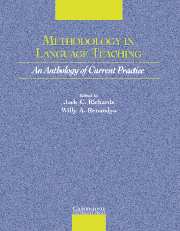Book contents
- Frontmatter
- Contents
- Acknowledgments
- Introduction
- Section I Approaches to Teaching
- Section 2 Lesson Planning and Classroom Management
- Section 3 Classroom Dynamics
- Section 4 Syllabus Design and Instructional Materials
- Section 5 Task and Project Work
- Section 6 Learning Strategies
- Section 7 Teaching Grammar
- Section 8 Teaching Pronunciation
- Chapter 16 Beyond ‘Listen and Repeat’: Pronunciation Teaching Materials and Theories of Second Language Acquisition
- Chapter 17 PracTESOL: It's Not What You Say, But How You Say It!
- Section 9 Teaching Speaking
- Section 10 Teaching Listening
- Section 11 Teaching Vocabulary
- Section 12 Teaching Reading
- Section 13 Teaching Writing
- Section 14 Assessment
- Section 15 Technologies in the Classroom
- Section 16 Professional Development
- Credits
- Author Index
- Subject Index
- References
Chapter 16 - Beyond ‘Listen and Repeat’: Pronunciation Teaching Materials and Theories of Second Language Acquisition
Published online by Cambridge University Press: 10 November 2010
- Frontmatter
- Contents
- Acknowledgments
- Introduction
- Section I Approaches to Teaching
- Section 2 Lesson Planning and Classroom Management
- Section 3 Classroom Dynamics
- Section 4 Syllabus Design and Instructional Materials
- Section 5 Task and Project Work
- Section 6 Learning Strategies
- Section 7 Teaching Grammar
- Section 8 Teaching Pronunciation
- Chapter 16 Beyond ‘Listen and Repeat’: Pronunciation Teaching Materials and Theories of Second Language Acquisition
- Chapter 17 PracTESOL: It's Not What You Say, But How You Say It!
- Section 9 Teaching Speaking
- Section 10 Teaching Listening
- Section 11 Teaching Vocabulary
- Section 12 Teaching Reading
- Section 13 Teaching Writing
- Section 14 Assessment
- Section 15 Technologies in the Classroom
- Section 16 Professional Development
- Credits
- Author Index
- Subject Index
- References
Summary
INTRODUCTION
Over the past half century, the fortunes of pronunciation teaching have waxed and waned. Irrelevant in the grammar translation approach, pronunciation grew in prominence with the rise of the Direct Method and Audiolingualism, only to be pushed again to the sidelines with the ascendency of Communicative Language Teaching (CLT) and the Natural Approach (Krashen, 1982). Today, pronunciation teaching is experiencing a new resurgence, fuelled largely by the increasing awareness of the communicative function of suprasegmental features in spoken discourse (Brazil, Coulthard, & Johns, 1980; Brown & Yule, 1983). In the late 1980s, researchers called for a more ‘top-down’ approach to pronunciation teaching (Pennington & Richards, 1986; Pennington, 1989), emphasizing the broader, more meaningful aspects of phonology in connected speech rather than practice with isolated sounds, thus ushering pronunciation back into the communicative fold. Materials writers responded with a wealth of courses and recipe books focusing on suprasegmental pronunciation (Bradford, 1988; Gilbert, 1984; Rogerson & Gilbert, 1990). A closer look at such materials, however, reveals that, with notable exceptions (Bowen & Marks, 1992; Bowler & Cunningham, 1991), most commercially produced course books on pronunciation today present activities remarkably similar to the audiolingual texts of the 1950s, relying heavily on mechanical drilling of decontextualized words and sentences. Although they profess to teach the more communicative aspects of pronunciation, many such texts go about it in a decidedly uncommunicative way. The more pronunciation teaching materials have changed, it seems, the more they have stayed the same.
- Type
- Chapter
- Information
- Methodology in Language TeachingAn Anthology of Current Practice, pp. 178 - 187Publisher: Cambridge University PressPrint publication year: 2002
References
- 5
- Cited by



